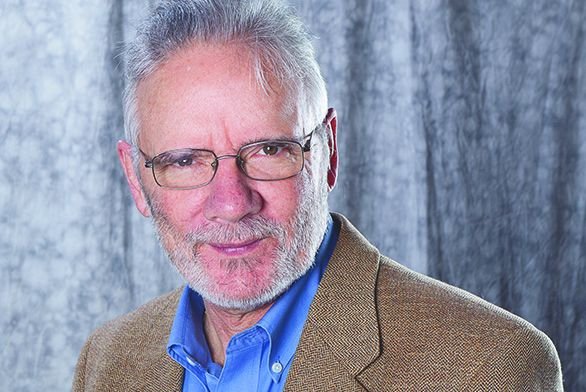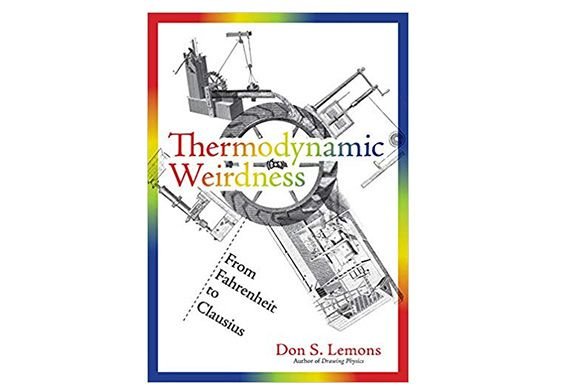Graduate Institute Alumnus Publishes Book on “Thermodynamic Weirdness”
April 2, 2019 | By Kimberly Uslin

Don Lemons (SFGI90) is the author of seven books, including Mere Thermodynamics, A Student’s Guide to Entropy, Drawing Physics: 2,600 Years of Discovery From Thales to Higgs, and most recently Thermodynamic Weirdness: From Fahrenheit to Clausius, which was published by The MIT Press on March 19.
What led you to the St. John’s Graduate Institute?
I think I first heard of St. John’s when I was in graduate school in the 1970s. I grew up in New Mexico, but for some reason St. John’s escaped me. I graduated from New Mexico State University and then went on to graduate school in physics, where I learned about St. John’s. When I got my first full-time job and moved back to Santa Fe, I took some time off from work and started taking a course at the GI. I took one by one, and it took me about 10 years. I graduated in 1991.
In the meantime, I had been working at Los Alamos National Laboratory as a physicist. I left and went to a small liberal arts college, where I taught physics to undergraduate students and freshman seminar. We had a capstone course in which we read original sources and had discussions and so forth, and my St. John’s experience helped me with that, which inspired me to keep going.
You continued to take preceptorials even after you had graduated, correct?
Yes, I’ve been doing one or two a year for the last several years now. I’ve been enjoying it.
What part of the program did you connect with the most?
It’s really hard to say. I did fall in love with Euclid in the science and math segment. I really loved working through Euclid Book One and through Lobachevsky’s theorems and proofs. I’ve incorporated them into my teaching; when my son was in third grade, I went to his class and had several sessions with a group of third-grade students and we looked at Euclid’s first six proofs.
How’d they do with them?
They enjoyed drawing the steps and the proofs. They made little notebooks. I don’t think it was too hard for them—it’s the propositions that do not involve the fifth postulate. They caught on.
What was it like studying the fundamentals of physics on the program as a physicist?
It was actually a liberation. You know, you do have to bite your tongue sometimes. But when you’re sitting around the table and you’re looking at the text, your first job is to try to figure out what the text is saying and try to understand it in its own terms. That’s what we did with Aristotle and Copernicus and Galileo. And it’s not all wrong, either. There are ideas in Aristotle that are still current.
The reading list upon which your book is based came from a preceptorial you didn’t actually attend. How did that happen?
The reading list was conveniently gathered up into a kind of pamphlet that the bookstore had. [The preceptorial] had already happened, and somehow I didn’t know about it, but it was about things I had interest in. I had previously written a book about thermodynamics, more the mathematical [side] of it, and I became fascinated with it. Someone introduced me to the tutor for the preceptorial, Howard Fisher, who’s a retired tutor who has taught both in Annapolis and Santa Fe and now lives in Santa Fe. We sat down in the coffee shop and discussed things. It was kind of my own personal preceptorial.
It struck me when I was talking to Howard that the people who I write books for—mainly undergraduate physics and math types—ought to know some of this stuff. It’s quite interesting, and in my mind, it solves a pedagogical problem: the subject of thermodynamics to a physics major, which presents itself as a strange beast. It doesn’t fit into what I call the Newtonian synthesis.

And that’s the crux of the book, Thermodynamic Weirdness?
The concepts and methods that Newton pioneered were immensely successful and defined physics. Even today, students begin studying physics [by] studying Newtonian methods and concepts. You expect everything to fit into that, and then you get to thermodynamics and the concepts just don’t fit. I think in delving a little bit into the history and emphasizing the conceptual difficulties that people had and the way ideas fit together, there’s a certain logic. That’s what Thermodynamic Weirdness emphasizes. It’s not particularly mathematical.
It’s a verbal presentation of ideas, conceptually and historically oriented. Most of the chapters are followed by a primary source—either an article written by one of the founders of thermodynamics or a selection from a longer work, starting with Daniel Fahrenheit, Lavoisier, Sadi Carnot, and so forth. I think any teacher who teaches thermodynamics to chemists, engineers, or physicists should find the book useful, and some of them may want to use it as collateral reading in their courses.
It’s not popular science, though, right? How would you describe its contents in layman’s terms?
It’s conceptually demanding. The right person might do fine with it, but it’s not a popular book. The whole subject of classical thermodynamics can be boiled down to two laws: the first and second laws. The first law is essentially the law of conservation of energy, and the second law restricts how heat can flow. How did those two laws arise?
Nowadays, we think of the law of conservation of energy as a trivial matter. But it’s a fairly abstract concept. I know when people think about thermodynamics, they usually think of entropy. Entropy is important, but it’s really a derived concept, and it’s derived from the first two laws. So [in the book], I show how these two laws arise and how they fit together.
Did Mr. Fisher play any role in the book’s publication?
After those initial conversations, I actually invited Howard [Fisher] to be a coauthor of the book but he demurred. I wrote it on my own and sent him drafts, and he commented [on them]. It’s a fairly short book. I told Howard it’s kind of my preceptorial essay.
How did your time at St. John’s influence this and your earlier books?
I like to place what we think of as the current state or current mathematical development in a larger historical context. I always approach [topics] with respect for the ideas that came before and the ideas that were replaced.

